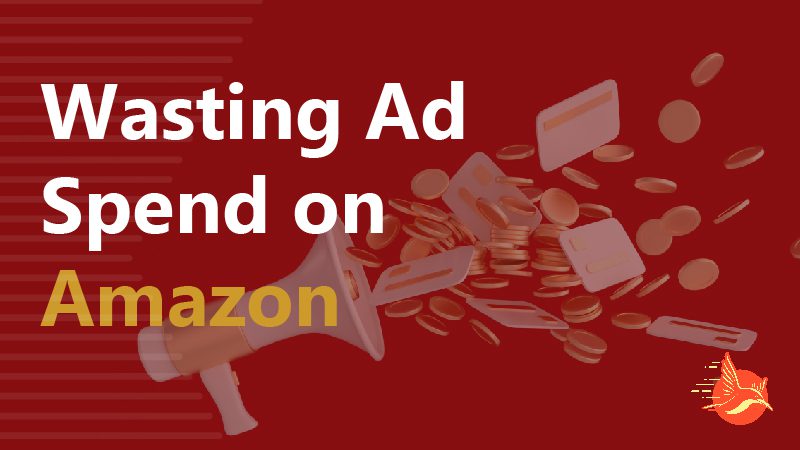Amazon, an unparalleled giant in the vast digital marketplace, is a hub for businesses and consumers alike. In this fiercely competitive digital realm, the importance of efficiently managing ad spend on Amazon cannot be overstated; advertising budgets can quickly evaporate like smoke in the wind. Every click in this space represents a potential sale, and the success of a business hinges significantly on the effectiveness of its advertising campaigns.
However, the Amazon advertising landscape is not without its challenges. Businesses often find themselves unwittingly squandering their ad budgets, with over 50% of potential clients experiencing significant wastage. Despite being carefully crafted, their ads fail to capture the attention of their intended audience and remain unclicked and unconverted.
But fear not; we are here to illuminate the path forward. Therefore, Our mission is to uncover these pitfalls and provide a clear roadmap to optimize your ad spend on Amazon effectively. This is essential in a platform where every dollar counts and strategic planning can make the difference between flourishing success and unnoticed efforts.
The Battle in Amazon’s Arena
- Entering the world of Amazon advertising can sometimes feel like stepping onto a battlefield. It’s a place where every click matters and every deal relies on the precision of your advertising strategy.
The Audit: Unveiling the Wastage
- Here’s where the audit comes into play. We’ll reveal how over 50% of potential clients experience significant ad spend wastage, meaning their ads, despite being carefully crafted, fail to capture the attention of their intended audience, leaving their budgets hemorrhaging.
The Pitfalls That Erode Budgets
- From overly broad keyword targeting to the perilous oversight of negative keywords, pitfalls are aplenty, and they can erode your bottom line. The startling truth is that many businesses unknowingly burn through their advertising budgets without achieving their desired results.
The Solution: Optimizing Ad Spend on Amazon
- We aim to dissect these challenges, offering actionable strategies to safeguard your advertising investments and unlock their full potential. Together, we’ll transform your Amazon advertising campaigns from costly endeavors into innovative, results-driven strategies that fuel growth and success.
So, let’s embark on this journey, armed with insights and strategies to navigate the complexities of Amazon advertising, ensuring your every ad dollar is an investment that propels your brand forward.
Understanding Amazon’s Advertising Strategy: Maximizing Ad Spend on Amazon
Amazon Advertising isn’t just an option;
Consequently, it’s a strategic necessity for businesses. Its significance as an advertising platform is deeply rooted in its vast audience and considerable purchasing power. With millions of daily visitors, Amazon provides a digital marketplace where brands can directly engage with consumers actively seeking products. To harness this potential, Amazon offers a diverse array of advertising options. Sponsored Products, for instance, enable you to prominently feature individual product listings, catching the eye of shoppers during their searches. Sponsored Brands, however, allow you to narrate your brand story and display multiple products simultaneously. And let’s remember Sponsored Display ads, which expand your reach beyond Amazon, targeting potential customers on and off the platform. These tools offer unmatched opportunities for businesses to boost visibility and drive sales.
Key Performance Indicators (KPIs)
These are the compasses in this challenging landscape. Metrics like TACoS (Total Advertising Cost of Sales), ACOS (Advertising Cost of Sales), and ROAS (Return on Ad Spend) guide your advertising efforts. TACoS gives you a comprehensive view of your advertising spending relative to your overall sales, helping you gauge the efficiency of your investments. ACOS zooms in further, focusing on the direct relationship between ad spend and sales. Finally, ROAS measures the returns you generate for every dollar spent on advertising. These KPIs are your guiding stars, allowing you to navigate the Amazon advertising landscape precisely. In the following sections, we’ll delve into specific tactics and strategies, including measuring and optimizing these KPIs, to ensure that every advertising dollar invested on Amazon yields a substantial return on investment.
However, this narrative has a twist: the intensifying competition within the Amazon ecosystem. Furthermore, as more businesses realize the potential of Amazon advertising, the digital battlefield becomes increasingly crowded. In addition, this growing competition highlights the critical need for cost optimization. In this fiercely competitive landscape, controlling ad spend isn’t just a financial consideration; it’s a survival strategy. Moreover, efficiently allocating your advertising budget becomes the linchpin of success, allowing you to maintain profitability and gain a competitive advantage.
The Cost of Inefficient Advertising
In the fast-paced realm of digital advertising, inefficient campaigns can be akin to financial vampires, silently draining your resources while failing to deliver the expected returns. Picture this: each click that falls short of conversion, every unnoticed impression, and every dollar squandered on inadequately targeted audiences compounds the financial strain on your business.
But what’s more concerning is that these inefficiencies often lurk in the shadows, silently siphoning off your ad budget, and many businesses are unaware that they’re falling prey to this predicament. A significant portion of ad spend is misallocated due to suboptimal practices within the expansive realm of Amazon advertising. It’s a hidden menace that stealthily erodes your budget.
Consider these eye-opening statistics: It’s estimated that as much as 20% of the ad budget allocated to Amazon campaigns may be squandered due to ineffective targeting and irrelevant keywords. To illustrate, this means that for every $1000 invested in advertising, a disheartening $200 might vanish into the digital abyss, generating no discernible returns. These figures underscore the critical importance of precision in your advertising endeavors.
The urgency of cost reduction is paramount in this landscape, and it’s not merely about implementing budget cuts; it’s about orchestrating a strategic shift toward intelligent allocation. In essence, inefficient advertising doesn’t just erode financial reserves; it erodes your competitive standing.
Ad Spend on Amazon: Uncovering the Hidden Waste
Even more astonishing is that many sellers are often unaware of this hidden wastage. They launch their campaigns with the best intentions, craft compelling ad creatives, and set their budgets, only to discover later that a significant portion of their investment has yielded minimal to no results. The digital realm can be deceiving, making it challenging to spot these inefficiencies without the right tools and insights.
For instance, many sellers don’t realize that they’re pouring ad spend into keywords that don’t resonate with their target audience or that their ad placements may not be optimal. This lack of visibility into where their ad dollars are going can be detrimental, especially in a competitive marketplace like Amazon.
At first, we aim to highlight these hidden pitfalls and empower you to identify and rectify them. Second, we leverage advanced analytics and data-driven strategies to unveil where your ad spend is being wasted, often revealing that most sellers don’t even know they’re squandering a significant portion of their budget. Moreover, we aim to ensure that every advertising dollar is treated as a precious resource, diligently channeled toward your goals rather than dissipating fruitlessly. In doing so, we’ll safeguard your financial health and competitive edge in the dynamic world of digital advertising.
Optimizing Ad Spend on Amazon: Identifying Wasteful Practices


In optimizing your advertising budget, it’s crucial to recognize and rectify standard wasteful practices that can erode your resources. There are five prevalent ways advertisers inadvertently dissipate their ad spend on Amazon :
Broad Keyword Targeting:
Casting too wide a net with overly broad keyword targeting can be costly. While it initially seems like a strategy to capture a more general audience, it often attracts clicks from users with only tangential interest in your products. These clicks, although increasing traffic, often lead to few and far between conversions.
Neglecting Negative Keywords:
The failure to employ negative keywords is akin to leaving the door open for irrelevant traffic. You need to specify which search terms should exclude your ads to avoid ad impressions and clicks from users looking for something entirely different. This not only drains your budget but also dilutes the effectiveness of your campaigns.
Ignoring Data Analysis:
Neglecting the invaluable insights from data analysis is akin to flying blind in advertising. Failing to examine the performance data of your campaigns means you’re making decisions based on hunches rather than evidence. Without data-driven optimization, you’re likely to overspend in areas that yield subpar results while neglecting opportunities for improvement.
Overspending on Irrelevant Audiences:
Misdirected targeting can quickly exhaust your ad budget. Overly broad audience segmentation or targeting demographics and interests that don’t align with your product offerings often results in high ad spending with minimal or zero return on investment. Your ads may reach many eyeballs but won’t attract genuine, interested customers.
Ignoring A/B Testing:
A/B testing is your compass for optimizing ad creatives and strategies. As a result, neglecting this invaluable tool means you’re missing out on crucial insights and improvements. Without A/B testing, you’re running campaigns without knowing what resonates with your audience, potentially leading to higher costs per click and lower conversion rates.
Bad Content’s Disruptive Impact:
It’s important to note that bad content can significantly disrupt your ad campaigns. Poorly crafted ad creatives, misleading messaging, or irrelevant content can deter potential customers and lead to wasted ad spend. Each of these practices can have a detrimental impact on your ad budget. In addition, broad keyword targeting and neglecting negative keywords drive costs by attracting unqualified clicks. Ignoring data analysis results in inefficient campaign management while overspending on irrelevant audiences allocates resources where they won’t yield results.
Each of these practices can have a detrimental impact on your ad budgets. Broad keyword targeting and neglecting negative keywords drive costs by attracting unqualified clicks. Ignoring data analysis results in inefficient campaign management while overspending on irrelevant audiences allocates resources where they won’t yield results.
Neglecting A/B testing means missing the chance to optimize your campaigns for better performance, ultimately squandering ad spend. In the following sections, we’ll delve deeply into these wasteful practices, providing actionable strategies to mitigate their impact and ensure that your advertising budget is a strategic asset, not an expenditure.
Strategies to Lower Ad Spend on Amazon
Effective management of your ad spend on Amazon demands a strategic approach. To begin with, here are five actionable tips that can empower you to optimize your advertising budget:
Effective Keyword Research and Targeting:
The foundation of cost-effective advertising lies in precise keyword research and targeting. You can attract highly relevant traffic by identifying long-tail keywords and optimizing your campaigns around them. For instance, a seller of premium coffee beans may uncover that “organic Arabica coffee beans” is a high-converting, less competitive keyword. Implementing this strategy led to a 30% reduction in their click cost while maintaining or improving conversion rates.
Leveraging Negative Keywords:
Negative keywords are your guardians against irrelevant clicks. For example, a retailer of high-end leather bags discovered that their ads were appearing for searches related to “cheap leather bags.” Adding “cheap” as a negative keyword eliminated budget-draining clicks from bargain hunters, resulting in a 25% reduction in ad spending while maintaining their ROI.
Regular Data Analysis and Adjustments:
The power of data analysis cannot be overstated. A skincare brand diligently analyzed its campaign performance data and detected that specific ad placements generated high click costs with minimal conversions. As a result, reallocating the budget to more effective placements reduced their cost per conversion by 15% within a month.
Audience Segmentation and Targeting:
Tailored targeting ensures your ads reach the most receptive audience. A fashion retailer identified that their dresses were popular among women aged 25-34. As a result of this discovery, by refining their targeting to focus exclusively on this demographic, they achieved a 20% reduction in ad spend and a 15% increase in sales.
Continuous A/B Testing:
A/B testing remains an indispensable tool for optimization. An electronics manufacturer continuously A/B tested their ad headlines, discovering that a concise, benefit-driven headline outperformed a more generic one. As a result of this testing, this led to a 10% reduction in cost per click and a 20% boost in click-through rates.
These strategies aren’t just theoretical; businesses have successfully applied them to achieve concrete results. By exploring these tactics with real-world examples and case studies, you can better understand how they work in practice. Armed with these insights, you’ll be well-prepared to embark on the journey of reducing your ad spend on Amazon while simultaneously enhancing your advertising ROI.
The Power of Compelling Content
In the fiercely competitive landscape of Amazon advertising, standing out from the crowd is paramount. One of the most effective ways to achieve this is through compelling content, particularly images and videos.
Captivating Images:
High-quality, eye-catching images are your first opportunity to make a positive impression. Clear, well-composed product photos can grab a potential customer’s attention and encourage them to explore further. A study by Amazon found that product listings with high-quality images enjoyed higher click-through rates.
Engaging Videos:
Videos, when used strategically, can be a game-changer. They allow you to showcase your product in action, explain its features, and create a more immersive shopping experience. Videos can tell a story and build a connection with your audience, increasing the likelihood of conversion.
Building Trust:
Better content isn’t just about aesthetics but building trust. Customers who see well-presented, informative images and videos are more likely to perceive your brand as professional and reliable. This trust can significantly influence their purchasing decisions.
Improved Conversions:
Compelling content isn’t just about attracting customers and converting them into buyers. A study by eMarketer found that adding a video to your product page can increase the likelihood of a purchase by 64%.
Investing in better content can make a world of difference in a digital marketplace where attention spans are limited. It’s not just about bringing customers in; it’s about converting them into satisfied buyers who return for more. So, when crafting your Amazon ads, remember the power of compelling visuals and videos—they can be the key to your advertising success.
Monitoring and Measuring Success


In the dynamic realm of Amazon advertising, staying vigilant and employing effective monitoring practices is akin to having a trusty compass in uncharted waters. To emphasize this analogy, without meticulous tracking, you risk navigating through a sea of data blindly, unsure if your campaigns are on course for success or adrift in a sea of inefficiency. The Importance of Tracking: Imagine embarking on a sea voyage without navigational instruments; it’s risky. Similarly, launching ad campaigns without robust tracking can pose significant risks to your advertising budget. Accurate tracking is your guiding star for campaign direction and empowers you to make timely course corrections to avoid potential pitfalls.
Setting precise Key Performance Indicators (KPIs) is like charting a well-defined course on your journey. These KPIs should align with your campaign objectives, acting as beacons illuminating the path to your advertising goals. Defining KPIs for Success: Suppose your mission is to elevate sales. In this scenario, metrics such as Return on Ad Spend (ROAS) and Conversion Rate become your North Stars. On the other hand, if you aim to expand brand visibility, metrics like Impressions and Click-Through Rate (CTR) take the helm. By establishing and regularly evaluating these KPIs, you gain the compass bearings essential for navigating your campaigns toward the shores of success.
Amazon equips you with tools and resources to help you navigate your advertising journey, providing valuable insights and navigation aids.
Amazon’s Reporting Dashboard:
Consider Amazon Advertising’s reporting dashboard in your ship’s command center. It offers comprehensive insights into your campaign performance, allowing you to monitor KPIs and plot your course toward optimization. For instance, tracking ROAS may reveal that a particular campaign delivers stellar results while another is merely treading water.
Third-Party Analytics Integration:
As seasoned mariners rely on advanced navigational instruments, integrating third-party analytics tools, like Google Analytics, can provide a broader view of your advertising seascape. These tools reveal where you’ve been and where hidden opportunities lie.
Campaign Reports:
Amazon offers a treasure trove of campaign-specific reports tailored to different ad formats—Sponsored Products, Brands, and Displays. Imagine having specialized maps for other parts of your voyage. These reports help you dive deeper into campaign performance, revealing which campaigns are smooth sailing and which need course corrections.
Example: Let’s say you’re an online retailer aiming to increase your brand’s visibility. You’ve set your sights on the Click-Through Rate (CTR) KPI. Regularly monitoring your Sponsored Brands campaign’s performance reveals that a specific ad group focused on seasonal products has a skyrocketing CTR. Armed with this insight, you can reallocate your budget to this high-performing ad group, enhancing the efficiency of your ad spend and ensuring your brand shines brightly amidst the Amazon marketplace’s competitive waves.
Amazon’s Advertising Strategy
Amazon’s Advertising Initiatives
- Diverse Advertising Tools: Amazon, the e-commerce titan, has revolutionized online shopping and pioneered a robust advertising ecosystem within its vast marketplace. With various advertising tools, businesses can effectively connect with their target audience. These tools encompass:
- Sponsored Products: A cornerstone of Amazon’s advertising suite, this tool allows brands to promote individual products within the search results and on product detail pages, driving visibility and sales.
- Sponsored Brands: Ideal for brand recognition, this format showcases a brand’s logo, a customizable headline, and a selection of products. It helps businesses create a compelling brand narrative that resonates with consumers.
- Display Ads: Beyond the immediate purchase intent of Sponsored Products and Sponsored Brands, Amazon’s display ads extend your reach across the web, offering banner and video ads that can capture the attention of potential customers as they browse other websites.
- Precise Audience Targeting: The unparalleled access to consumer data sets Amazon’s advertising apart. This treasure trove of information empowers advertisers to perform exact audience targeting. By harnessing data on consumers’ shopping habits, preferences, and past purchases, advertisers can tailor their campaigns to reach the most relevant audience segments.
Example: Imagine a niche seller offering organic, gluten-free snacks. With Amazon’s advertising tools, they can specifically target health-conscious shoppers who have a history of purchasing similar products. This precision ensures that their ad dollars are channeled towards consumers more likely to convert, resulting in a higher return on investment.
Amazon’s Long-term Advertising Strategy
Sustained Investment:
Amazon views advertising as more than a supplementary revenue stream; it’s a fundamental pillar of its growth strategy. Their commitment to sustained investment in advertising is evident through the continual expansion and improvement of their advertising offerings. This investment ensures that Amazon’s advertising landscape is a dynamic and evolving space that presents new opportunities for advertisers.
Innovation and Expansion:
Amazon’s long-term vision extends well into the future. They’re dedicated to ongoing innovation in the advertising sphere. This encompasses:
Refining Ad Offerings:
Amazon consistently refines its advertising offerings based on feedback and market trends. This iterative approach means advertisers can expect ever-improving tools and features to enhance their campaigns.
Enhancing Targeting Capabilities:
Amazon recognizes the power of data and aims to improve its targeting capabilities further. The more precise advertisers can reach their desired audience, the more effective their campaigns become.
Exploring New Advertising Avenues:
Amazon is not confined to its platform. They are actively exploring advertising opportunities beyond Amazon.com. This expansion means advertisers can potentially engage with their audience across a broader digital landscape.
Example: Amazon’s acquisition of Whole Foods Market exemplifies its innovative strategy. By integrating its online retail and offline grocery presence, Amazon is pioneering new avenues for advertisers. Imagine a shopper walking through a Whole Foods store, guided by intelligent displays recommending products based on their online shopping history. In essence, this seamless online and offline advertising integration represents Amazon’s commitment to reshaping the landscape.
In the dynamic realm of Amazon advertising, optimizing your ad spend is not just a strategy; it’s a necessity. Throughout this journey, we’ve uncovered vital takeaways to help you navigate these uncharted waters:
Wasteful Practices:
Recognize standard wasteful practices like broad keyword targeting, neglecting negative keywords, ignoring data analysis, overspending on irrelevant audiences, and neglecting A/B testing. Addressing these issues is the first step to optimizing ad spend.
Strategies for Efficiency:
Armed with effective methods such as precise keyword research, leveraging negative keywords, regular data analysis, audience segmentation, and continuous A/B testing, you can steer your campaigns toward efficiency.
Monitoring and Measuring:
Vigilant tracking and measurement of Key Performance Indicators (KPIs) are crucial for success. By setting clear KPIs, you gain insights into the effectiveness of your campaigns and can make data-driven adjustments.
Amazon’s Advertising Landscape:
Recognize Amazon’s position as a leader in the advertising landscape. Understand their diverse advertising tools and their long-term commitment to innovation and expansion.
The importance of optimizing ad spend on Amazon cannot be overstated. It’s not just about conserving resources but maximizing the return on your advertising investment. Every dollar spent inefficiently is a missed opportunity for growth.
As you embark on your Amazon advertising journey, we encourage you to implement the strategies discussed here. In essence, from refining your targeting to meticulous data analysis and embracing A/B testing, these tactics are your compass, guiding you toward efficient ad spend and improved results.
You may also read about Why You Need to Be Brand Registered on Amazon: Maximizing the Benefits for Success

